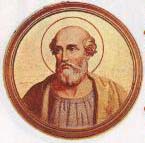Pope Hyginus
| Saint Hyginus | |
|---|---|

| |
| Birth name | Hyginus |
| Papacy began | ca. 138 |
| Papacy ended | ca. 140 |
| Predecessor | Telesphorus |
| Successor | Pius I |
| Born | ??? Athens, Greece |
| Died | ca. 140 Rome, Italy |
Pope Saint Hyginus, also called Yginus, was a bishop of Rome from about 138 to about 142. He was born in Athens, Greece, at an unknown date. Tradition holds that during his papacy he determined the various prerogatives of the clergy and defined the grades of the ecclesiastical hierarchy. However, modern scholars tend to doubt this claim and view the governance of the church of Rome during this period as still more or less collective.
While Hyginus was active in the leadership of the Roman church, the gnostic teacher Valentinus began to spread his doctrine among the Roman Christians as did the "heretic" Cerdo. Hyginus is said to have died a martyr under the persecution of Roman Emperor Marcus Aurelius, although no ancient records confirm this. His feast day is commemorated on January 11.
Biography
Like all of the early bishops of Rome, questions arise as to whether Hyginus should truly be considered a "pope" or one of several bishops (episcopi) who governed the Christian church at Rome in a more collective manner. Nothing is known with certainty about Hyginus' background, and even the dates in office are a matter of conjecture. He succeeded Telesphorus, who, according to the fourth century church historian Eusebius (Church History IV.15), died during the first year of the reign of the Emperor Antonius Pius, which would be in 138 or 139. However the chronology of these bishops of Rome cannot be determined with any degree of exactitude. For example, the Liber Pontificalis itself gives conflicting dates for his reign, one manuscript saying ten years and another saying four. Eusebius (Church History IV. 16) agrees with the second figure. The best estimates of modern scholars, based on the dates of those who preceded and followed him, put his reign at no more than four and as little as two years.
The Liber Ponificalis states that Hyginus was a Greek by birth, although its author admits that "I have not been able to ascertain" his ancestry. This source further states that before assuming office, he had been a philosopher. However, this may be due to the similarity of his name with that of two Latin philosophical writers. Irenaeus of Lyons, writing in the late second century, provides information indicating that the Gnostic teacher Valentinus came to Rome in Hyginus's time, remaining there until Anicetus became pontiff (Against Heresies III.3). Cerdo, a proto-Gnostic and the predecessor of Marcion in teaching that the deity of the Old Testament was an inferior god and not the same as the Heavenly Father of Jesus Christ. He lived at Rome in the reign of Hyginus. Cerdo's career in the church was a checkered one, being apparently expelled and then gaining readmission after recanting his errors, and then being expelled again ((Against Heresies III.3). It is not certain, however, what Hyginus' role in these affairs might have been. Most likely, he was one of the leading bishops or elders who would have had to make the difficult decisions whether to expel teachers of unauthorized doctrines.
The Liber Pontificalis claims that Hyginus organized the church hierarchy and established the duties of the various offices. However, this same general observation recurs in the biography of Pope Hormisdas three centuries later and is consider to have no historical value, since the Liber routinely assigns the early popes legislative accomplishments in a clearly anachronistic manner.
The most ancient sources contain no information as to his having died a martyr. However, as with all the early popes, later traditions honor him as such. At his death, he is said to have been buried on the Vatican Hill near the tomb of Saint Peter. His feast is celebrated on 11 January.
| Roman Catholic Popes | ||
|---|---|---|
| Preceded by: Telesphorus |
Bishop of Rome Pope 138–140 |
Succeeded by: Pius I |
ReferencesISBN links support NWE through referral fees
- Attwater, Donald, and Catherine Rachel John. The Penguin Dictionary of Saints, 3rd edition. New York: Penguin Books, 1993. ISBN 0140513124.
- Chapman, John. Studies on the Early Papacy. Port Washington, NY: Kennikat Press, 1971. ISBN 9780804611398.
- Fortescue, Adrian, and Scott M. P. Reid. The Early Papacy: To the Synod of Chalcedon in 451. Southampton: Saint Austin Press, 1997. ISBN 9781901157604.
- Loomis, Louise Ropes. The Book of Popes (Liber Pontificalis). Merchantville, NJ: Evolution Publishing. ISBN 1889758868.
This article incorporates text from the public-domain Catholic Encyclopedia of 1913.
| ||||||||||||||||
Credits
New World Encyclopedia writers and editors rewrote and completed the Wikipedia article in accordance with New World Encyclopedia standards. This article abides by terms of the Creative Commons CC-by-sa 3.0 License (CC-by-sa), which may be used and disseminated with proper attribution. Credit is due under the terms of this license that can reference both the New World Encyclopedia contributors and the selfless volunteer contributors of the Wikimedia Foundation. To cite this article click here for a list of acceptable citing formats.The history of earlier contributions by wikipedians is accessible to researchers here:
The history of this article since it was imported to New World Encyclopedia:
Note: Some restrictions may apply to use of individual images which are separately licensed.